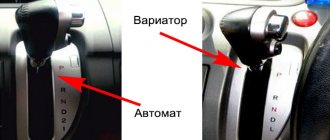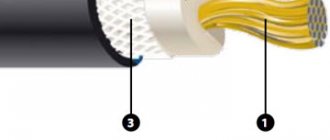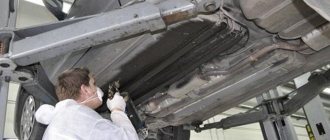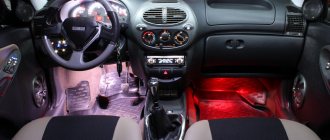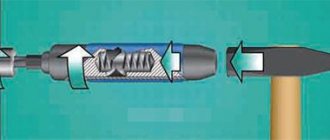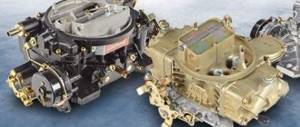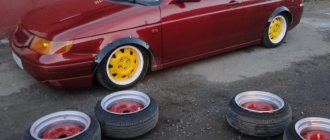Why is this necessary?
Everyone knows why a car needs aerodynamics. The more streamlined its body, the lower the resistance to movement and fuel consumption. Such a car will not only save your money, but will also emit less rubbish into the environment. The answer is simple, but far from complete. Aerodynamics specialists, fine-tuning the body of the new model, also:
- calculate the distribution of lift force along the axes, which is very important given the considerable speeds of modern cars,
- provide air access for cooling the engine and brake mechanisms,
- think over the places of air intake and outlet for the interior ventilation system,
- strive to reduce noise levels in the cabin,
- optimize the shape of body parts to reduce contamination of glass, mirrors and lighting equipment.
Moreover, the solution to one task often contradicts the implementation of another. For example, reducing the drag coefficient improves streamlining, but at the same time worsens the vehicle's resistance to crosswind gusts. Therefore, specialists must seek a reasonable compromise.
Reduced drag
What determines the force of drag? Two parameters have a decisive influence on it - the aerodynamic drag coefficient Cx and the cross-sectional area of the vehicle (midsection). You can reduce the midsection by making the body lower and narrower, but it is unlikely that there will be many buyers for such a car. Therefore, the main direction of improving the aerodynamics of a car is to optimize the flow around the body, in other words, to reduce Cx. The aerodynamic drag coefficient Cx is a dimensionless quantity that is determined experimentally. For modern cars it lies in the range of 0.26-0.38. In foreign sources, the aerodynamic drag coefficient is sometimes denoted Cd (drag coefficient). A teardrop-shaped body, Cx of which is 0.04, has ideal streamlining. When moving, it smoothly cuts through air currents, which then seamlessly, without breaks, close in its “tail”.
Air masses behave differently when the car moves. Here, air resistance consists of three components:
- internal resistance when air passes through the engine compartment and interior,
- frictional resistance of air flows on the external surfaces of the body and
- form resistance.
The third component has the greatest impact on the aerodynamics of the car. While moving, the car compresses the air masses in front of it, creating an area of high pressure. Air flows flow around the body, and where it ends, the air flow separates, creating turbulence and an area of low pressure. Thus, an area of high pressure in the front prevents the car from moving forward, and an area of low pressure in the rear “sucks” it back. The strength of the turbulence and the size of the area of low pressure are determined by the shape of the rear part of the body.
The front part and side surfaces of the car do not cause much trouble for designers in terms of aerodynamics. The main thing here is to avoid sharp transitions and protrusions, thereby preventing the air flow from being separated from the surface of the body.
But with the rear part of the body everything is much more complicated. As you might guess, station wagons are the least aerodynamic - their shape least resembles an ideal “drop”. Behind their extensive “back” an impressive vacuum zone is formed, which not only reduces Cx, but also “sucks in” dust and dirt settling on the rear window. Its harmful effects can be slightly reduced by installing a deflector on the top of the fifth door. It directs part of the air flow downward, reducing vacuum and reducing contamination.
Not everything is simple with hatchbacks, although, at first glance, their shape seems to be the most streamlined. The impression is deceptive - a prime example of the unpredictability of aerodynamics. Cx of hatchbacks depends on the angle of the rear end. At a large angle of inclination (and the majority of such models), the flow process is practically no different from station wagons - the air flow breaks away from the upper edge of the roof and creates a significant vacuum zone.
As the tilt angle decreases to 30-35 degrees, the flow separation point moves to the lower edge of the rear part. It would seem that the vacuum zone and, accordingly, Cx should decrease. But, paradoxical as it may seem at first glance, the opposite happens. The fact is that in this case, air flows from the sides of the body, falling on an inclined surface, form edge vortices, which, twisting in a spiral, create an even larger vacuum zone behind the car. They combat this phenomenon with the help of a spoiler installed on the edge of the roof. In this case, the flow separation point moves from the lower edge of the rear part to the upper one, which prevents the formation of edge vortices and somewhat improves the overall aerodynamics.
But if you reduce the tilt of the rear to 20-23 degrees, the air flow from the roof flows almost perfectly around the car, breaking away from the lower edge. In this case, edge vortices are no longer formed, and the vacuum zone is minimal. But such cars lose practicality and therefore there are very few of them among production models.
The best aerodynamic performance is demonstrated by cars with a stepped rear end - sedans and coupes. The explanation is simple - the flow of air that escapes from the roof immediately hits the trunk lid, where it is normalized and then finally breaks off from its edge. Side flows also fall on the trunk, which prevents harmful vortices from arising behind the car. Therefore, the higher and longer the trunk lid, the better the aerodynamic performance. On large sedans and coupes, it is sometimes even possible to achieve continuous flow around the body. Slightly narrowing the rear also helps reduce Cx. The edge of the trunk is made sharp or in the form of a small protrusion - this ensures separation of the air flow without turbulence. As a result, the vacuum area behind the car is small.
The underbody of the car also affects its aerodynamics. Protruding parts of the suspension and exhaust system increase drag. To reduce it, they try to smooth out the bottom as much as possible or cover with shields everything that “sticks out” below the bumper. Sometimes a small front spoiler is installed. A spoiler reduces air flow under the car. But here it is important to know when to stop. A large spoiler will significantly increase resistance, but the car will “snuggle” to the road better. But more on this in the next section.
Windage
Author: Julius Mackerle Source: "Modern economical car" [1]57037 5
Fuel consumption, especially at high speeds, is significantly influenced by air resistance (aerodynamic drag) , the aerodynamic drag force is proportional to the square of the speed and is calculated by the formula
Pv = cx·S·v2·ρ/2,
where S is the frontal projection area of the car, m2; v – vehicle speed relative to air, m/s; ρ – air density, kg/m3; cх – aerodynamic drag coefficient.
Aerodynamic drag does not depend on the mass of the vehicle [2]. The frontal projection area of the car is determined by the shape of the body and the requirements to ensure a comfortable position for the driver and passengers in the seats. For example, a large car may be lower than a small one, since its seats are often lower. In a small car, due to its light weight and length, the seats are located higher above the floor, and therefore the distance between the front and rear seats is smaller. The more upright position of the driver and passengers in a small class car requires it to be taller but shorter. The frontal projection areas of both cars are almost the same, but the low and long body of a large class car is aerodynamically more advantageous .
The engine power required to overcome aerodynamic drag is therefore proportional to the cube of the speed:
Nv = Pv v/3600 (kW),
where v is the relative speed of the vehicle, km/h.
The aerodynamic drag coefficient, as can be seen from the table below, varies over a wide range depending on the shape of the car body.
Aerodynamic drag of various cars
| 1,18 – 1,47 | 9,6 – 11,8 | 31,0 – 40,5 | ||
| Closed, with corners and edges | 0,6 – 0,7 | 0,96 – 1,18 | 8,0 – 9,6 | 26,4 – 30,8 |
| Closed, with rounded corners and edges | 0,5 – 0,6 | 0,80 – 0,96 | 6,6 – 8,0 | 22,0 – 26,4 |
| Closed pontoon | 0,4 – 0,5 | 0,66 – 0,80 | 5,2 – 6,6 | 17,6 – 22,0 |
| Closed, well streamlined | 0,3 – 0,4 | 0,52 – 0,66 | 3,7 – 5,2 | 13,2 – 17,6 |
| Closed, aerodynamically perfect | 0,20 – 0,25 | 0,33 – 0,44 | 2,6 – 3,3 | 9,8 – 11,0 |
| Freight car | 0,8 – 1,5 | – | – | – |
| Bus | 0,6 – 0,7 | – | – | – |
| Bus with a well-streamlined body | 0,3 – 0,4 | – | – | – |
| Motorbike | 0,6 – 0,7 | – | – | – |
The aerodynamic drag coefficient is determined by blowing the car or its mock-up in a wind tunnel or approximately during operational tests . When tested in a wind tunnel on mock-ups, less accurate values are obtained than from the same tests on real cars. This is due to the fact that the change in air resistance is influenced by inaccuracies in the manufacture of some components and parts of the car: door handles, underbody, bumpers, rear-view mirrors, etc. In addition, the air passing into the body for cooling and ventilation.
At high vehicle speeds, aerodynamic drag is predominant.
The figure below shows the change in power required to overcome rolling resistance Nf and aerodynamic resistance Nv as a function of speed v for a mid-range car. At a speed of 60 km/h, the power required to overcome rolling resistance and air resistance is equal, which is typical for this type of car. Based on the sum of power consumed, one can see the importance of air resistance. At a speed of 80 km/h, the power required to overcome it is 4 times greater than at a speed of 40 km/h, and at speeds higher than 120 km/h, the total power required for movement increases almost in proportion to the cube of the car's speed .
| Power expended to overcome movement resistance |
| The mass of the car is 1350 kg, the front projection area S of the car is 2 m2; rolling resistance coefficient f is 0.015; the aerodynamic drag coefficient cx is 0.456. |
When determining the engine power required to achieve a maximum speed greater than that provided by the rated power of the engine installed on the vehicle, the following relationship can be used without significant error:
N2 = N1·(v2/v1)3,
where N2 – required power, kW; N1 – achieved maximum power, kW; v2 – required speed, km/h; v1 – achieved maximum speed, km/h.
Through point X - the maximum power N1 at the maximum speed v1 - a curve of power versus cube of speed is drawn. The difference between this curve and the line of power required to drive at maximum speed is negligible.
The shown sum of the powers of rolling resistance Nf and aerodynamic resistance Nv represents the power of resistance to the uniform movement of a car along a horizontal section of the road in a calm environment.
Last updated 03/02/2012 Published 03/16/2011
Top
Downforce
When a car moves, the air flow under its bottom goes in a straight line, and the upper part of the flow goes around the body, that is, it travels a longer distance. Therefore, the speed of the upper flow is higher than that of the lower flow. And according to the laws of physics, the higher the air speed, the lower the pressure. Consequently, an area of high pressure is created under the bottom, and a low pressure area is created above. This creates lift. And although its value is small, the trouble is that it is unevenly distributed along the axes. If the front axle is loaded by the flow pressing on the hood and windshield, then the rear axle is additionally unloaded by the vacuum zone formed behind the car. Therefore, as speed increases, stability decreases and the car becomes prone to skidding.
Designers of conventional production cars do not have to come up with any special measures to combat this phenomenon, since what is done to improve streamlining simultaneously increases downforce. For example, optimization of the rear end reduces the vacuum area behind the car, and therefore reduces lift. Leveling the underbody not only reduces resistance to air movement, but also increases the flow rate and therefore reduces the pressure under the car. And this, in turn, leads to a decrease in lift. In the same way, the rear spoiler performs two tasks. It not only reduces vortex formation, improving Cx, but also simultaneously presses the car to the road due to the air flow pushing away from it. Sometimes a rear spoiler is intended solely to increase downforce. In this case, it is large in size and tilted or is made retractable, starting to work only at high speeds.
For sports and racing models, the measures described will naturally be ineffective. To keep them on the road, you need to create more downforce. For this purpose, a large front spoiler, side skirts and wings are used. But when installed on production cars, these elements will only play a decorative role, pleasing the owner’s vanity. They will not provide any practical benefit; on the contrary, they will increase resistance to movement. Many car enthusiasts, by the way, confuse a spoiler with a wing, although it is quite easy to distinguish them. The spoiler is always pressed against the body, forming a single whole with it. The wing is installed at some distance from the body.
Top cars with the best Cx
We will consider car brands from larger Cx to smaller. But in any case, they all deserve the highest praise in terms of aerodynamics.
Alfa Romeo Giulia
To mark the 110th anniversary of the founding of Alfa Romeo, its engineers released a new model with improved aerodynamics and handling. And although consumers associate this brand with sports cars, this time it was a sedan. His Cx coefficient was 0.24.
@search.creativecommons.org
The body shape, which allows for increased downforce, is borrowed from Formula 1. High aerodynamic properties were achieved due to the front splitter and rear wing made of carbon. It was this combination that provided balance in the load when driving at high speeds.
Hyundai Sonata Hybrid
The pride of the South Korean automobile industry has Cx = 0.24. Thanks to improvements in aerodynamics, the car has become as economical as possible. On electric power alone, the hybrid can accelerate to 120 km/h.
@search.creativecommons.org
And by switching to a gasoline engine, it will use 5.9 liters of fuel per 100 km. The total power plant is 206 hp. With.
Audi A4
In the Audi A4 family, only the 2.0 TDI ultra can boast good performance. It is this model that has Cx = 0.23. Audi ultra has a power of 190 horsepower. And excellent aerodynamic performance was achieved thanks to special shields shielding the bottom.
@youtube.com/TEST DRIVE FREAK
Active shutters in the radiator grille also play an important role in this matter. In all other A4 models, the aerodynamics are quite modest: in the range of 0.26–0.27. Only with the 2.0 TDI ultra you will be able to consume 3.4–3.5 liters of diesel fuel per 100 km, and in urban areas – only 3.9–4 liters.
Mercedes CLA
If you want to get aerodynamics at the level of 0.23, choose not just the CLA, but specifically the BlueEfficiency version, since the sports versions have a much higher Cx coefficient. For example, the CLA 250 4Matic has a coefficient of 0.29, while the AMG 45 has a coefficient of 0.3. In these models, manufacturers sacrificed streamlining by reducing lift at top speeds.
@search.creativecommons.org
The S class also has questions in this regard. After all, only the S 300 h satisfies the requirements of modern times, and even the “six hundredth” shows a modest aerodynamic coefficient of 0.28.
Tesla Model 3
“An electric car for the people,” naturally American, was presented in 2020. With its Cx = 0.21, the model demonstrates aerodynamic wonders when compared with other mass-produced cars, and not with individual prototypes.
@ru.wikipedia.org
The body of the golf-class sedan is made in a super-streamlined shape. Having just appeared on sale, 300 thousand people made pre-orders for the super-Tesla. Consumers are offered two series: standard and premium.
General Motors EV1
Having been born in the 90s of the last century, this particular model was considered the best in the world for many years. The General Motors EV1 Cx coefficient is 0.195.
@ru.wikipedia.org
Initially, the model was planned as an electric car, receiving the name of the manufacturer itself. Although cars are usually given the names of manufacturers' brands. For some reason, the two-seater coupe, capable of accelerating to 160 km/h, was never put into mass production. Only 1,117 EV1 models were produced. Apparently the EV1 was way ahead of its time.
Volkswagen XL1
This model is more reminiscent of a space alien in appearance. The shape of the wafer with invisible rear wheels allows us to achieve Cx = 0.189. The miracle Volkswagen can move thanks to a hybrid power plant with a diesel engine.
@search.creativecommons.org
Manufacturers claim that this car of the future will be able to consume only 1 liter of fuel for every 100 km of travel. And all this thanks to the wonderful properties of aerodynamics. But you are unlikely to be able to buy the XL1. After all, it was released in a limited edition of only 250 pieces.
